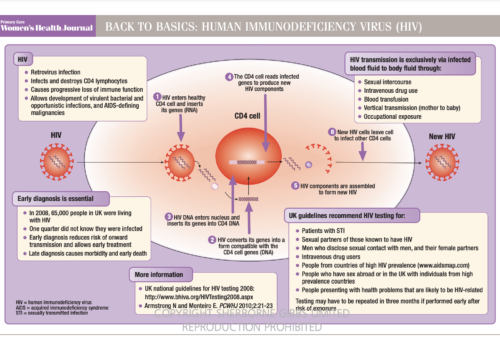Part 1 explained how powerful a diet can be in lowering low density lipoprotein-cholesterol (LDL-C) and reducing cardiovascular risk published in BJPCN 2011;8:36-8. Part 2 will focus on the practical step-by-step approach of the Ultimate Cholesterol-Lowering Plan (UCLP) by introducing an alternative consultation technique and detailing the core food elements of the UCLP.1-7 The UCLP includes a number of key strategies each scientifically proven to provide a dose-response effect to cholesterol reduction or cardiovascular risk.
Back to Basics: Human Immunodeficiency Virus (HIV)
Intrauterine system: informed choice for women and GPs
The intrauterine system (IUS) is a very effective long-acting reversible contraceptive (LARC) for appropriate women. But myths and misconceptions may cause some patients to opt for other, less reliable or suitable methods. Addressing frequently asked questions will help GPs to prescribe with confidence and enable women to make informed decisions about their contraception.
The Forum takes action as the voice for women
The Primary Care Women’s Health Forum is now over one year old. When we met to establish the Forum, we set ourselves several aims and objectives. As we celebrate our first anniversary, our membership continues to grow and we are beginning to deliver on our major objectives: to be the voice for women and improve their healthcare.
Vaginal thrush (Candidiasis)
COPD: Serious, chronic and becoming more common in women
Chronic obstructive pulmonary disease (COPD) is a largely preventable, slowly progressive, inflammatory disease. Rates of COPD are rising faster in women than in men, yet women are less likely to be diagnosed. There is currently no cure, but best-practice management outlined in recently updated NICE guidelines can help to improve patients’ symptoms and quality of life.
Identifying and supporting women with puerperal psychosis
The birth of a new baby is usually seen as a cause for celebration. But following delivery, a woman has a greater likelihood of psychiatric admission to hospital than at any other point in her life. This is often due to puerperal psychosis, a serious mental illness requiring prompt recognition and medical treatment. Primary care professionals are well placed to identify early symptoms to minimise risks to mother and baby.
Take a sexual history in primary care
Many primary care clinicians worry about how to take an appropriate sexual history. Raising the issue seems straightforward when a woman has symptoms or when contraception or cervical screening feature in a consultation. The challenge occurs when the possibility of sexual health issues may not be so apparent to the patient.
Training for nurses improves care for women
Many advanced nurse practitioners (ANPs) are working in innovative ways to enhance patient care in general practice. But little specific training has been available for ANPs in women’s health. This article outlines how a training course was developed specifically to improve and maintain local ANPs’ competencies in managing women’s health in primary care.
Older people and HIV: A call to action
Thanks to effective treatment, people with HIV are living longer than ever. Older people are now the fastest growing group with HIV in the UK, and as many as one in five adults accessing care is now aged over 50 years. But treatment does not mean cure, and a targeted approach to support is needed, as well as action to halt the growing numbers of older women and men affected by HIV.
PCOS or overweight? Solving the diagnostic dilemma
Polycystic ovary syndrome (PCOS) is the commonest endocrinopathy, affecting 5-12% of women. Every aspect has been controversial from its nomenclature to its management. But accurate diagnosis based on consensus guidelines ensures that treatment can be tailored effectively to each woman’s symptoms and needs.
Stroke prevention in atrial fibrilliation: How can we improve management in primary care?
Atrial fibrillation (AF) is an important – yet preventable – cause of stroke. About 12,500 strokes each year are thought to be directly attributable to AF.1 Cost-benefit analysis from the Department of Health suggests that for stroke patients with AF there are about 4,300 deaths in hospital, 3,200 discharges to residential care and 8,500 deaths […]























